Rowena Street Park Restoration Project
What you need to know
The Rafting Ground Restoration Project, led by Malcolm Frost of MCCG is part of a $2.1M Brisbane wide “What’s your nature?” urban waterway restoration initiative, funded by SEQ Catchments through the Australian Government. An agreement was signed between Moggill Creek Catchment Group (MCCG) and SEQC for MCCG to act as Project Manager to undertake restoration work within Rowena Park, which is part of Rafting Ground Reserve. The agreement was for a four year program with SEQC undertaking to fund MCCG a total of $90,000.
A work agreement was signed between MCCG and Brisbane Bushcare Pty Ltd to undertake clearing weeds and planting natives. A scope of work over the four years was agreed. The creek banks about Rowena Park was divided into four zones (see photograph of the park below) with the intention of working sequentially on the four zones over the four years but returning to each zone for maintenance.
Andrew Wilson, an experienced botanist, has now completed a botanical survey of the area commissioned in October. A list of native species and weeds is presented in the Appendix below.
Two 800mm x 1200mm x 5mm Coreflute signs have been placed in the park to advertise the Project.
Before any work was undertaken, Roger Jaensch, Jaensch Ornithology & Conservation kindly visited the site and showed us the location of the Lewin Rails which nest hidden in the creek banks.
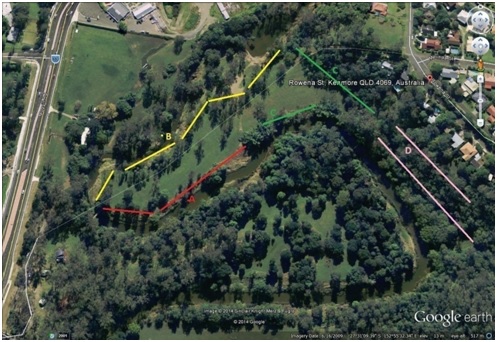
Rowena Street Park with the four zones defined
In view of the lack of rainfall during late 2014, it was decided to change the original scope of work. In particular, no planting was undertaken until good rain occurred. Cats Claw Creeper was identified within Zone D and Brisbane Bushcare was asked to curtail this dangerous weed by selective spraying. The original infestation was considered to occur mainly below the path but Brisbane Bushcare discovered older and larger outcrops above the path. These were stem sprayed and will be monitored next year as they will likely recur.
We have not identified all the Cats Claw and it would greatly assist us if residents who come across this dangerous weed would mark it and let us know. For more details on Cats Claw refer to other sections of MCCG web site.
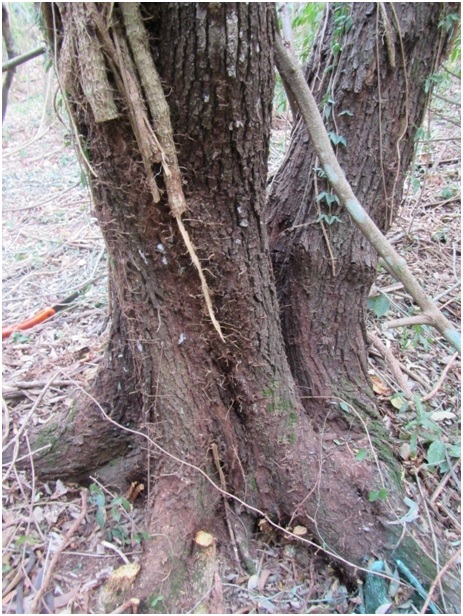
Treated Cats Claw
Andrew Wilson who is acting as our Project Botanist identified an invasive weed Justicia betonica (Shrimp weed) which is being removed. Running bamboo found to be spreading in Zone D above the path has been cut back and treated with herbicide.
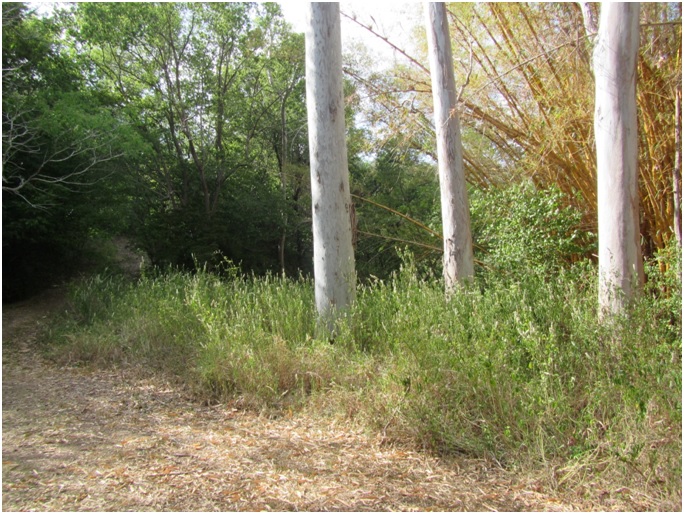
Justicia Betonica before treatment
The drought ended in December and as consequence it was decided to begin planting along Zone A. Some hand weeding and site preparation was conducted and then altogether 770 tube stock plants and 24 canopy trees were planted mainly along the upper bank. Immediately after the planting there were two very hot days which caused about 5% of plants to die. Good rain followed after the hot spell.
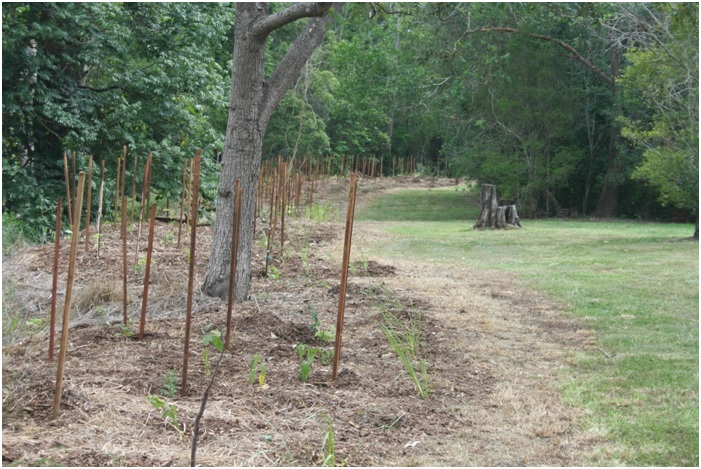
Part of the Zone A creek bank planted
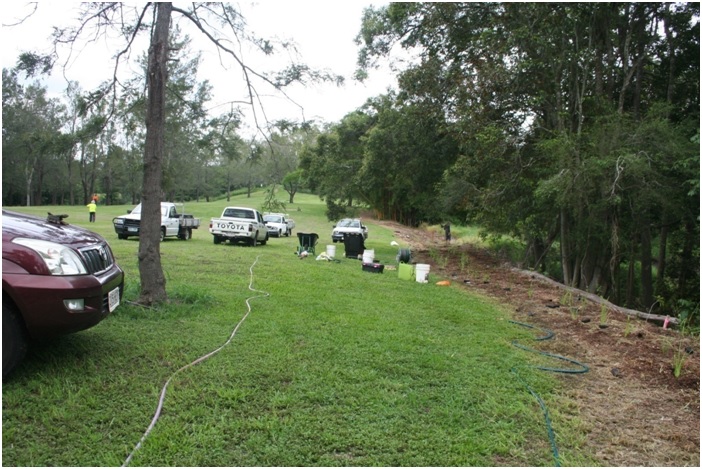
Brisbane Bushcare’s planting team along Zone A
Fortunately, the impact of the flooding caused by cyclone Marcia did not cause significant damage to the planting along Zone A. However, it is a matter of concern to MCCG that significant erosion occurred along the steep bank of Zone B.
MCCG strongly recommends that Council undertakes remedial action as soon as possible to reduce the hazard to the public and to minimise future removal of significant alluvia to Moreton Bay by erosion of the park.
As expected, thousands of Castor oil seedlings continue to appear and will be removed continually over the next year.
It is a matter of great concern that after the major flooding caused by cyclone Marcia part of the steep bank along Zone B has been heavily eroded so that some of these plants are now precariously situated on the cliff edge.
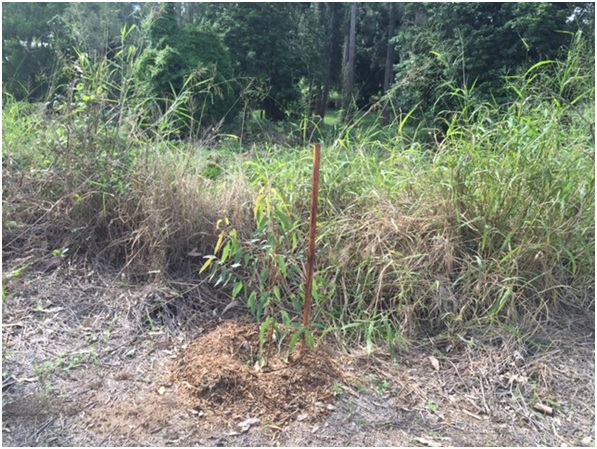
A planting along the bank of Zone B before Marcia. Note the bank covered by weeds that separated the plants from the creek.
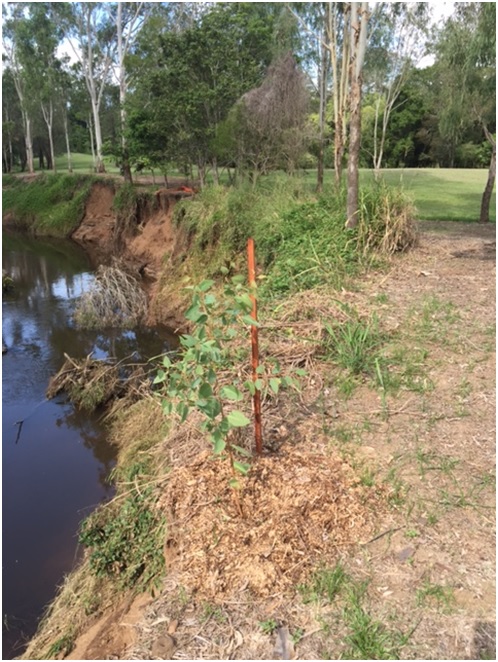
The same plant after Marcia. Note that between 1.5 and 2m of creek bank has been eroded.
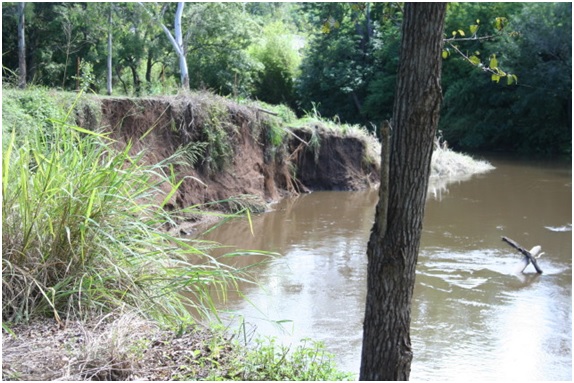
A general view of the creek bank after Marcia. Note the steep cliff that lies immediately on the park side.
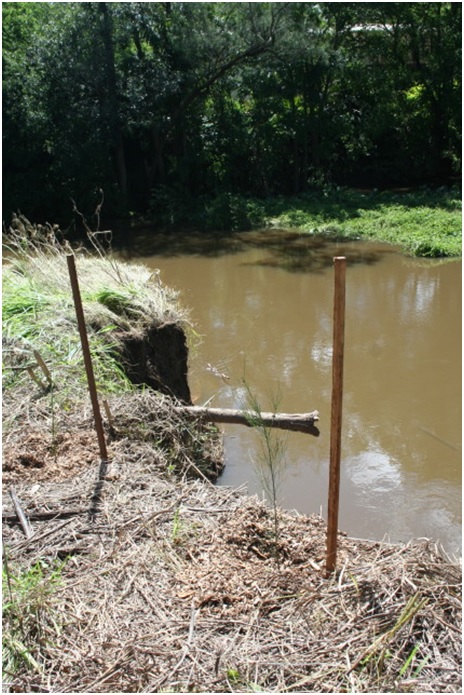
A Casuarina now grows precariously on the edge
Click to see the List of Native Plants identified before restoration, and the List of Weed Species in Rowena Park.
How residents can help to restore the park
- Write, email or phone Council expressing your delight that restoration work is going on in Rowena Street Park.
- Come down to the park and discover how you could help in the restoration work.
In addition a letter, email or phone call to Council to:
- Encourage Council to support a gradual removal of Chinese elms below Rowena Street to the creek bank (see below why these trees need to be removed) .
- Express your concern that flash flooding is causing severe erosion along one side of the park (see photo below)and as a consequence is causing a cliff near the foot bridge which is a hazard to kids playing on the grass . Moreover, this erosion is resulting in tonnes of alluvium being swept into Moreton Bay.
- Encourage Council to fund the removal of a fast spreading exotic shrub Sickle Bush (Dichrostachys cinerea). In Cuba for example, this plant has destroyed close to five million acres (20,000 km²) of agricultural land. Its thorns are often 8cm long and as a consequence are a safety hazard to any community park.
- Tell us of any Cats Claw Creeper that you find both in your gardens and in the park.
Contact Councillor Matthew Bourke, Role of Chairman of Council’s Environment:
- Shop 146a Mount Ommaney Centre, 171 Dandenong Road, Mount Ommaney Qld 4074
- Email: [email protected]
- Phone: 3407 7000.
Restoring the Riparian Zone
Rowena Street Park riparian zone has an extensive area of Celtis Sinensis (Chinese Elms), which need to be removed and replaced by native trees and vegetation. Read on for more details on why Celtis Sinensis must be removed, and on our approach for tackling this problem.
Celtis sinensis are beautiful exotic deciduous trees. In open park land they grow quickly into well shaped large trees up to 40m high. However, they cause extensive damage to native flora in SE Queensland. Annually, mature trees produce thousands of small orange berries which germinate readily and are spread by birds. If left unchecked, a single mature Celtis sinensis can spread throughout an area of up to 1 square kilometre or greater through seeds dispersed by bird droppings.
One major issue with the tree is that because the leaves are very acidic, below the tree the Celtis sinensis creates its own micro ecosystem which prevents all but the most acid-loving plants from surviving.
Only a very small percentage of native flora can compete with the Celtis sinensis. As a consequence, the germination is prolific and dense areas of Celtis sinensis saplings (frequently about 100 to 200mm apart) develop around mature Celtis sinensis .These gradually grow into tall thin trees and very little else grows in these thickets (See the photo below).
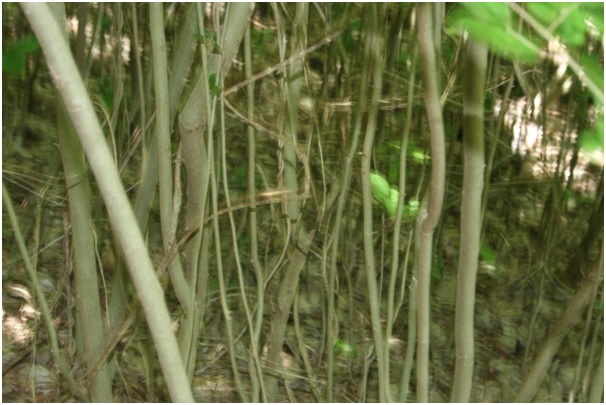
An example of how Celtis sinensis develops a dense array of saplings.
In addition, Celtis sinensis has a buttress root system which is extremely invasive and has a vigorous water-seeking nature. As a result the tree is resistant to flash flooding damage.
However, if the objective is to remove heavy infestation of Celtis sinensis from creek banks to restore native vegetation, care must be taken when large trees are removed, to protect banks from erosion while native plants become established. There are many native trees which are as effective in protecting creek banks but they are usually much slower growing.
So long as maintenance of an area continues over a wide area for a few years Celtis sinensiscan be eradicated from a creek bank, in contrast to say glycine, Cats Claw or Madeira vine which probably never can be completely eradicated. Such maintenance is not difficult. A pass through the restored area once a year is sufficient.
Celtis Sensis Proposed Eradication Procedure
1: In Year 1 select 20-30m of creek bank. Experience has shown that it is unwise to clear areas of bank longer than this. One has to expect that Celtis sinensis seeds from further along the bank will germinate in the selected area but these are easily removed. As the length of restored bank is extended fewer and fewer Celtis sinensis saplings will be found. No more than about two seeding trees should be removed either by side winding or felling over each stretch of selected bank. If felled, the stump should be 1-2m high. Round up should be applied to the stump but it should be emphasised that in spite of such treatment stumps take several years to completely die. See the photographs below.
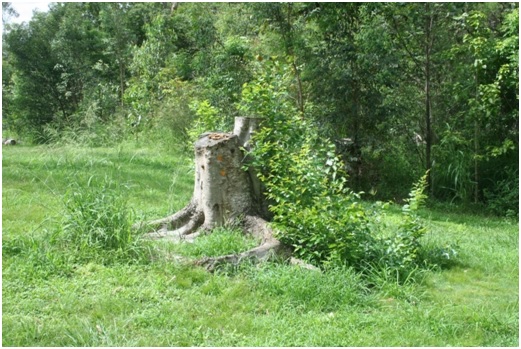
This very large Celtis sinensis was felled in early 2013. Repeated pruning has failed to kill the tree. Notice that the regrowth is coming from the trunk and from the buttress roots.
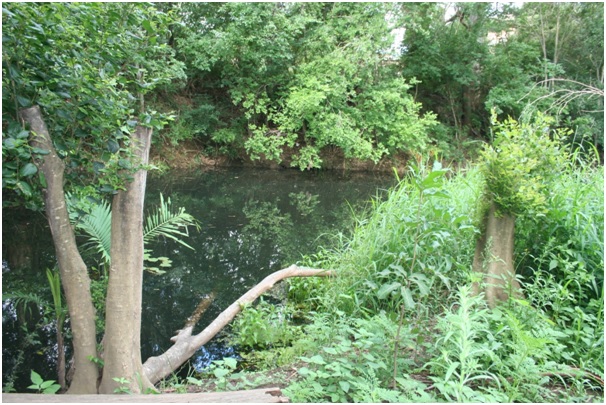
This Celtis sinensis adjacent to Moggill Creek was felled by Council in early 2013. Note that in spite of pruning it is still growing vigorously. Since the tree was felled the creek has been subjected to severe flash flooding which has not affected the tree or its roots so that that the stump can be used to protect bank erosion while native plants are maturing ; of equal importance the tree is not producing any seeds
2. When a seeding tree is felled, thousands of seeds that were dormant in the ground often germinate immediately to form a grass-like cover. This germination is probably caused by more light falling on the ground. These germinating Celtis sinensis can easily be removed by Round Up with foliate spraying, taking care not to poison any native plants (if any) that may be present.
3. Around mature seeding Celtis sinensis there are frequently found dense masses of Celtis sinensis saplings (see illustration above). These are best cut down with a brush cutter with steel blade. Round up on the cut stems will kill these easily and after about 2 months the small stumps will rot.
4. Native species which are known to resist flash flooding should be planted immediately. The list presented by Land for Wild Life, with a few additions, is an excellent set of native species. Each native tree should be staked with the stake up stream to add some protection from fast water and from debris flowing with the water. As the trees grow taller, smaller stakes should be replaced by larger ones.
5. Over the years many mistakes in restoration procedures have been made, mainly relating to restoration of lower banks which are subjected to more extreme flash flooding. Removal of trees over a long stretch of lower bank, with subsequent control of grass by foliate spraying was found to be unsatisfactory as exposure of soil before native plants matured caused significant soil erosion, with many native trees being swept away by flooding. A better option has been found to be clearing seeding Celtis sinensis and Celtis sinensissaplings along short stretches of creek bank . With the resulting sunlight on the creek bank exotic grass (e.g Ehrharta erecta? or panic grass) will flourish to inhibit soil erosion. Exotic grasses will grow higher and quicker than most of the natives so that the grass must be controlled by brush cutting while the native plants grow tall. If the grass is not reduced in height to be below the growing natives, the natives will mostly die or grow very slowly. Planting natives in the grass and controlling the grasses by treating with herbicide a 1m circle about each plants was one more mistake (see photo below). Plants should be planted into the grass with as little disturbance of the grasses as possible.
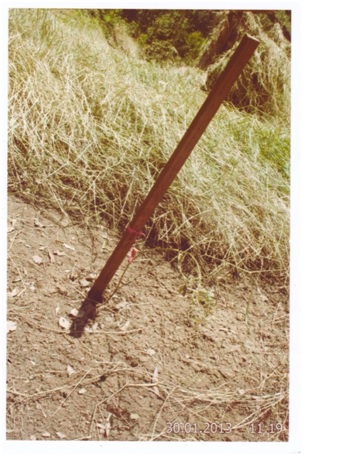
A eucalypt was planted in the thick grass and an area about the plant was treated with herbicide. The grass died but subsequent flash flooding caused extensive soil erosion about the small area that had been treated with Round Up although the untreated grass and its soil remained.
6. The exotic grass will inhibit natural regrowth of under storey native plants. However, it can be demonstrated that once the native tree canopy becomes nearly mature, these grasses tend to die away and then native under storey plants can be established (see photo below).
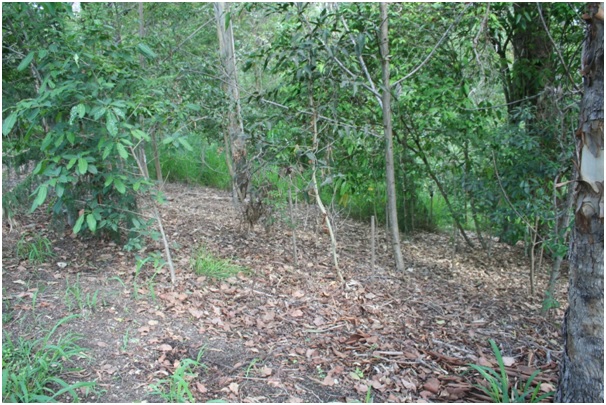
A stretch of creek bank where weed trees have been removed about 10 years ago and replanted with natives. These trees form a canopy which keeps most of the light from the ground. Notice the exotic grasses no longer grow but in the area closer to the creek, where there are no trees, exotic grasses flourish
7. Regular weeding, further planting of natives and pruning of mature seeding elms that are sprouting is essential.
Strategy for restoring Zone D at Rowena Street Park
Year 1
- Remove all seeding trees and saplings, together with other weeds such as Ochna, from an area of bank above the path leading through Zone D from Rowena Park (see photograph below).
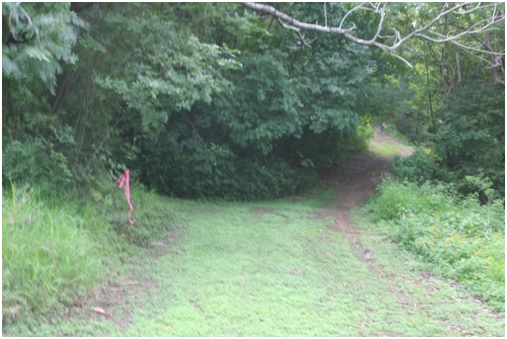
Restoration of beginning of area of Zone D. Photograph taken from Rowena Park where the path begins. The creek is to the right and many metres below the path. Flash flooding is unlikely to occur on the bank to the left of the path. Two pieces of red tape mark the length of bank for restoration.
- Carry out planting and maintenance applying the procedures described above.
- Remove one Celtis sinensis which is close by the path and on the creek side, bending over towards the creek
Year 2
- Regular maintenance of first 20-30m of creek bank.
- A further 20-30m of creek bank, below the area which was cleared of all weeds including Celtis sinensis saplings and 2-3 seeding Celtis sinensis
- Follow steps 2 to 6.
The procedures should be repeated for the following years. If any Celtis sinensis remain in the restored areas they should of course be removed.

